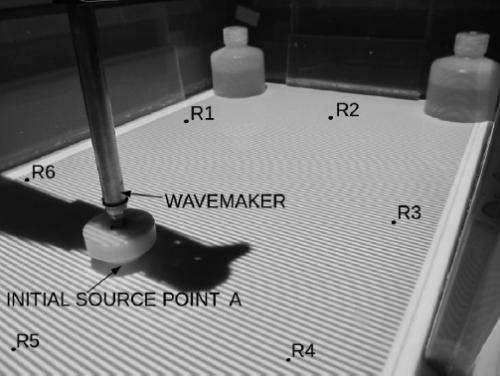August 23, 2012 feature
Physicists demonstrate first time reversal of water waves

(Phys.org)—In spite of its name, the time reversal of a wave doesn't involve sending the wave back in time, but for scientists, the process is almost as compelling. After a source generates a wave, the wave propagates through a medium and is recorded at a few points in its surroundings by an optical method. Then, the wave is re-emitted in a way so that its energy focuses back at the initial source position, as though the wave were being played backwards. Because the wave precisely retraces its original path as it travels back to its source, its mathematical description is reversed in time but is otherwise exactly the same.
While scientists have extensively studied the time reversal of acoustic, elastic, and electromagnetic waves in previous research, a new study marks the first experimental demonstration of the time reversal of water waves. The researchers, from ESPCI ParisTech and CNRS in Paris and Le Mans, France, have published their results from the demonstration in a recent issue of Physical Review Letters.
The scientists explain that, although water waves are very common and easily observable, they are much more complicated than acoustic, elastic, and electromagnetic waves. For example, water waves are dispersive by nature and experience strong damping at small scales, meaning that wave amplitude decreases due to fluid viscosity and friction with the bottom and walls of the water tank. Due to these complications – damping in particular – water waves have never been tested in a time reversal experiment, although they have been investigated theoretically.
But as the scientists demonstrate here, water waves in a small laboratory tank can still exhibit time reversal in spite of the strong damping. The researchers filled a 53 x 38 cm2 (21 x 15 in2) tank with water to a depth of 10 cm (4 in). To generate waves, they used a vertical vibrator in the middle of the tank, which can be considered as a point source. The surface elevation was measured in six different locations, then time-reversed and re-emitted, leading to the spatial and temporal wave refocalization at the source. The researchers demonstrated that the use of only one re-emitter can successfully refocus a wave.
"This work clearly shows that time-reversal symmetry is really a universal concept in wave physics," coauthor Mathias Fink at CNRS in Paris told Phys.org. "It applies to any kind of waves: seismic, acoustic, electromagnetic, and water waves. It can be used to build time-reversal mirrors that are very robust devices, and despite the fact that we conducted water-wave time-reversal experiments in a reverberating cavity of chaotic shape, the time-reversed wave refocuses back exactly towards its source. We were surprised to see that despite the dissipative nature of water waves, the multiply reflected signals by the tank boundaries were strong enough to participate efficiently to the time-reversed waves, providing a better focusing quality even with a small number of vibrators."
To measure the waves, the researchers used an optical method called Fourier Transform Profilometry (FTP). The method enabled them to measure surface elevation with good spatial and temporal resolution, allowing them to recreate a map of surface elevation at different times.
"Once we measure the propagating wave, we choose a few points," explained coauthor Adam Przadka at CNRS in Paris. "At those points, we have a signal in time that we time-reverse numerically (we switch the signal). Then we generate waves by the conical wavemaker that moves vertically, inputting energy to the system."
The researchers also investigated how to improve the quality of the refocusing by using the multiple reflections from the tank boundaries, or in other words, the similarity of the original wave to the time-reversed wave. As expected, they found through their simulations that decreasing the damping to a negligible amount increases quality. However, negligible damping would be difficult to achieve in a lab experiment since it would require a water tank the size of a swimming pool to minimize the contributions of damping. Another factor that increases quality is increasing the number of re-emitting channels.
While the current experiment illustrates the feasibility of the time reversal of water waves using just a few channels and with damping, simulations at larger scales, with negligible damping and more channels, indicate the possibility of very high-quality time reversal. These findings could pave the way toward a variety of ocean-based applications.
"The fact that time-reversed water waves can be easily focused at any location in complex media can lead to interesting applications as water wave control in a harbor," Fink said. "For example, if in a harbor, there is a zone where there are usually high-amplitude waves due to constructive interference and to the geometry of the shallow water structure, you can imagine controlling this phenomenon by using a set of vibrators immersed in the sea that focuses waves out of phase of these patterns to allow the wave field. It is like an anti-noise technique for acoustics. There can also be interesting applications by time-reversing the wake radiated by a moving boat. The anti-wake created by this process can be an efficient way to remotely push a boat or a solid structure along the water surface."
More information: A. Przadka, et al. "Time Reversal of Water Waves." PRL 109, 064501 (2012). DOI: 10.1103/PhysRevLett.109.064501
Fluid Dynamics Video for the Gallery of Fluid Motion: arXiv:1010.3311v1 [physics.flu-dyn] 128.84.158.119/abs/1010.3311
Journal information: Physical Review Letters
Copyright 2012 Phys.Org
All rights reserved. This material may not be published, broadcast, rewritten or redistributed in whole or part without the express written permission of PhysOrg.com.




















